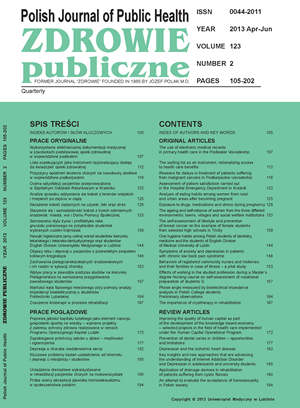The use of electronic medical records in primary health care in the Podlaskie Voivodeship
DOI:
https://doi.org/10.12923/j.0044-2011/123-2/a.01Keywords:
electronic medical record (EMR), electronic health record (EHR), health information technology (HIT, e-healthAbstract
Introduction. Despite the statutory obligation to keep medical records only in electronic form from August 1, 2014, there are no publications in the scientific literature on the current level of preparation of institutions in this regard.
Aim. The aim of this study is to determine the current level of the use of electronic medical records by primary care physicians in the Podlaskie Voivodeship.
Material and methods. The study was conducted using the CATI (Computer Aided Telephone Interviews) and the CAWI (Computer Aided Web Interview) methods. In total, results were obtained from 104 Primary Health Care units (PHC), which accounts for 44% of all health care providers having a contract for the provision the primary care physician services in the Podlaskie Voivodeship.
Results. The results show that only 14.7% of primary care physicians use the individual electronic medical record. As regards external medical records, prescription are generated and printed by 71.6%, medical referrals – by 39.8% and medical certificates – by 11.8% of the respondents. Transmission of medical data over the Internet pra-ctically does not exist, except for the access to the results of laboratory tests, which is declared by 28.2% of respondents.
Discussion. Despite the fact that currently all the doctors declare access to computers and the Internet in the PHC institutions, these resources are used primarily for the purpose of billing and verification of patient insurance status, not for keeping electronic medical records. The case of Denmark, where the use of electronic medical records among general practitioners reaches 100% indicates that the process is long-lasting, and it was achieved with strong substantial and financial support from the state.
Conclusions. In view of the computerization of the health care system in Poland, special attention should be paid to the computerization of healthcare providers themselves, including in particular providers of primary health care level. The concentration of efforts and resources only on central projects and computerization of hospitals may be a highly inefficient solution.
References
1. Chaudhry B, Wang J, Wu S, et al. Systematic review: impact of health information technology on quality, efficiency and costis of medical care. Ann Intern Med. 2006;144:742-52.
2. eHealth for a Healthier Europe! – opportunities for a better use of healthcare resources. Gartner: Sweden; 2009.
3. Ustawa z dnia 28 kwietnia 2011 r. o systemie informacji w ochronie zdrowia. (Dz.U. 2011 nr 113 poz. 657).
4. Dobrev A, Haesner M, Husing T. Benchmarking ICT use among General Practitioners in Europe – final report. Bonn; 2008.
6. Widelska U, Dębkowska K, Michalczuk G, et al. Badanie obszaru e-zdrowie projektu „E-podlaskie, kierunki rozwoju społeczeństwa informacyjnego województwa podlaskiego”. Białystok; 2011.
7. Groves RM, Fowler Jr FM, Couper MP. Questionnaire Methodology. John Wiley & Sons, Inc.; 2009.
8. European Commission. Information Society and Media Directorate General, Benchamarking ICT use among General Practitioners in Europe 2007. Country Profile; Poland; 2007.
9. Schoen C, Osborn R, Squires D, et al. A Survey of Primary Care Doctors in Ten Countries Shows Progress in Use of Health Information Technology, Less in Other Areas. Health Aff (Millwood). 2012;31(12):2805-16. Review match
10. Protti D, Johansen I. Widespread Adoption of Information Technology in Primary Care Physician Offices in Denmark: A Case Study. The Commonwealth Fund; 2010.
11. Gray BH, Bowden T, Johansen I, et al. Electronic Health Records: An International Perspective on “Meaningful Use”. The Commonwealth Fund; 2011.
12. Field S. NHS 60 – a GP’s view. J R Soc Med. 2008;101(7):335-7.
13. Baranowski J, Windak A. Optymalizacja polskiego systemu finansowania podstawowej opieki zdrowotnej. Sprawne Państwo. Warszawa: Program Ernest & Young; 2012.
14. Pike Ch. An Empirical Analysis of the effects of GP Competetition. Londyn: Co-operation & Competition Panel Working Paper Series, London; 2010.


